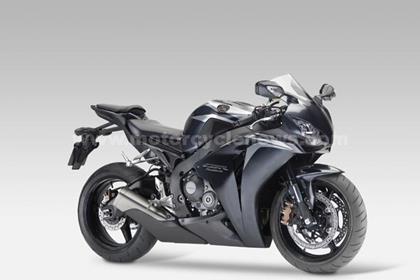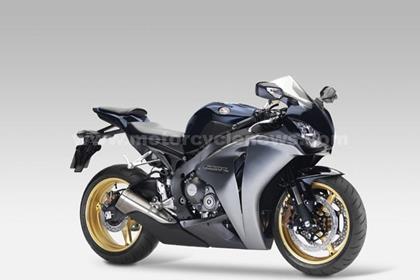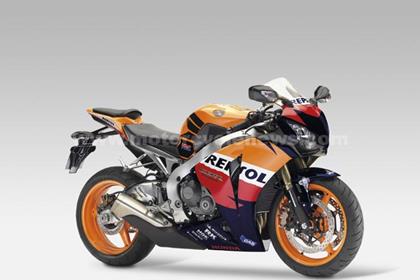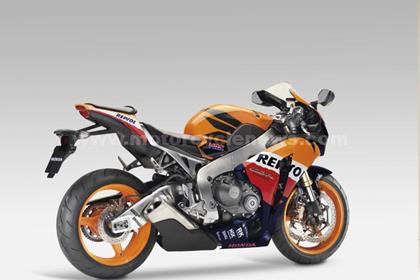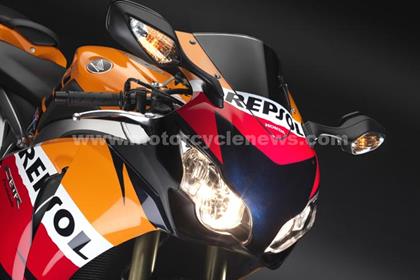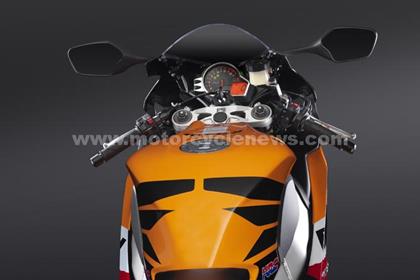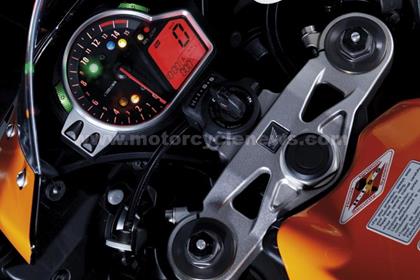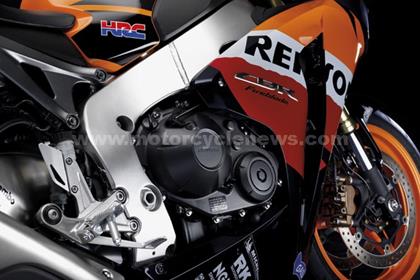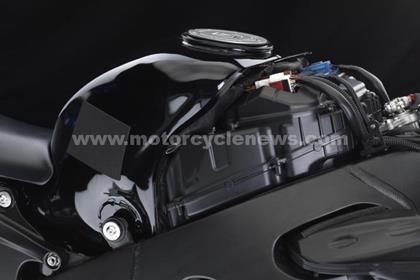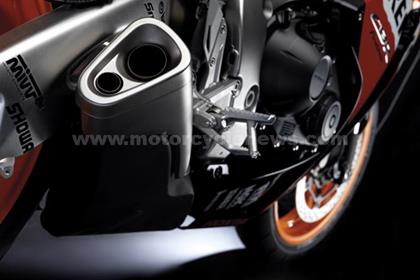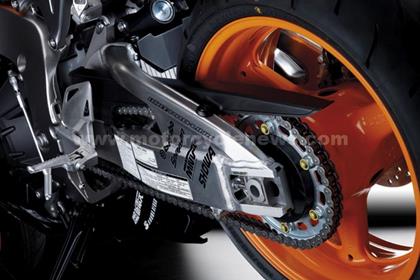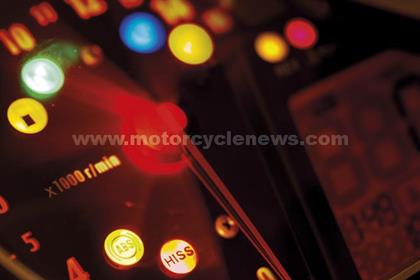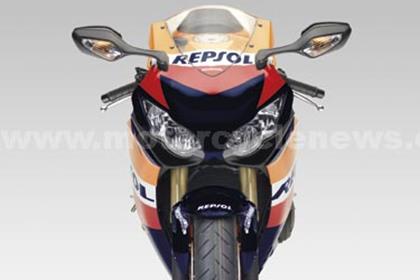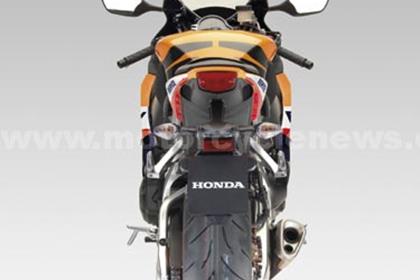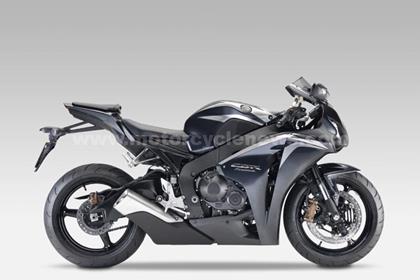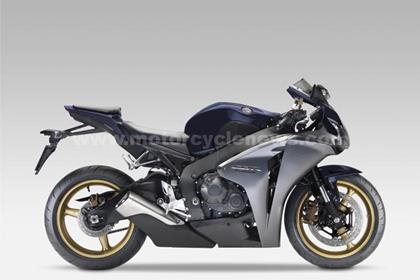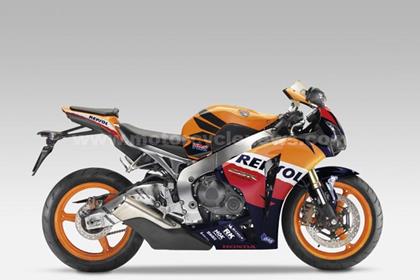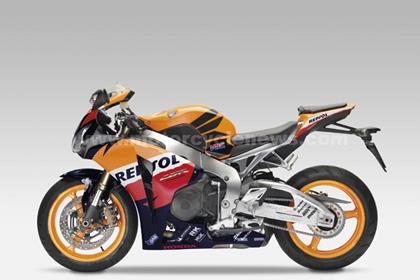2009 Honda Fireblade ABS - First official pictures
The flagship Honda CBR1000RR Fireblade becomes the first superbike to get ABS in 2009 and comes in a range of new colours.
The optional anti-lock brakes have been designed specifically for fast track riding. Honda claims that in tests of the anti-lock version against expert riders on non-ABS Blades, the experts needed several attempts before they could out-brake the ABS bike into a corner. That means mere mortals should be able to get an instant improvement in lap times.
The new system also limits forward pitching and rear wheel lift, according to Honda – great for keeping the bike settled on that track, not so good if you like stoppies.
Bodywork in the ABS version has been changed to cover the system, which Honda says has been made to be as compact and light as possible. An extension of the fairing covers the front power unit near the engine while a black under-seat cowl covers the electronic control unit.
The CBR1000RR Fireblade for 2009 comes in an HRC Tri-colour scheme, Repsol Race replica livery, metallic black or pearl blue. The engine has been given a matt black finish.
The standard version has black brake callipers while the combined ABS – or C-ABS – version has metallic ones.
Check out the press release below to read the full details of the bike and browse the image gallery of the Honda Fireblade on the right to see it in all it’s glory.
Honda’s Official press release for the 2009 Honda Fireblade
Introduction
Development Concept
Styling
Colouring Concept
Engine
Exhaust
Frame
Brakes
Optional Equipment
Introduction
The world of motorcycling is already well aware of the CBR1000RR Fireblade’s standing in the elite realms of the ultimate sportsbike. Incredibly light, fast and controllable, the iconic Fireblade has built a well-deserved reputation for delivering the full-blooded joy of extreme performance. Almost miraculously, it manages to combine this with a smooth, refined and cultured experience that makes every ride a pleasure, even when it’s not ten tenths.
At the heart of the Fireblade’s philosophy since the model was first launched in 1992 has been the concept of Total Control.
When the 1998 Fireblade was first revealed, there were collective gasps from onlookers and riders alike. The machine was so pared-down, with all unnecessary weight and bulk removed, that you could actually see right through the bike in some places. That same philosophy of minimalist design and “nothing that doesn’t absolutely need to be there” has been carried over through successive generations of the CBR.
Since that first model, the Fireblade has become even more compact, with Honda’s concept of mass centralisation becoming an ever more important feature of the design. Focusing as much of the bike’s weight as possible towards the centre of gravity enhances the Fireblade’s agility, stability and overall handling, and produces a machine that has astonishingly nimble and controllable behaviour. Whether the rider is tipping the bike into slow corners or slicing it into the fastest of bends, the Fireblade responds with razor-sharp, yet predictable and surefooted handling that makes it a joy to ride.
In 2008 the Fireblade received major revisions which constituted another radical leap in performance, and once again stretched the machine’s lead ahead of the competition. A super-light all-new engine brought immense levels of power accompanied by increased smoothness and refinement of delivery. The result was a machine that would drive with sublime smoothness in every situation, crisp throttle response giving the rider precisely the level of acceleration they require at any moment – whether easing gently out of a slow, slippery mountain hairpin or powering-on hard in a fast race track curve. The result was true to the all-important concept of Total Control – giving the rider exactly what they want, and thus building confidence.
The all-new chassis was equally responsible for the Fireblade’s continuing success and ever-growing reputation as the ultimate road-going sports bike. The super-slim four-piece cast aluminium frame provided the ideal basis on which to build the Fireblade’s extraordinary handling prowess. Combining the stiffness required to harness the engine’s formidable power with the compliance needed to gain maximum traction when banked hard in corners, the frame is a masterpiece of efficient design.
Compact dimensions contribute to the all-important mass centralisation, while also giving the rider the maximum flexibility and movement over the machine to achieve the optimum weight distribution for any given riding conditions.
A visual overhaul saw the Fireblade receive a stunning new shape reflecting both the machine’s ultra-modern core and the simplicity of the “light is right” concept. Inspired by the craftsmanship and culture of Japan’s ancient history, the new machine was the essence of pure Japanese engineering.
For 2009, the Fireblade sees the addition of high performance electronically-controlled “Combined ABS” as an option. Continuing Honda’s determination to enhance motorcycle safety at every opportunity, the highly-advanced Combined ABS system is a remarkable and ground-breaking first for a bike in its class.
For many years Combined ABS has offered a dramatic confidence benefit to emergency braking situations where the machine’s wheels can lock, resulting in a loss of control. But never before has a system been developed that has the necessary refinement, low weight and performance to suit a Super Sports bike like the Fireblade. Until now.
Honda has developed an all-new, lightweight system that befits the Total Control concept of the entire bike. For a minimal weight increase, the confidence of Combined ABS can now be enjoyed by the Super Sports rider who demands the highest performance in every facet of a motorcycle.
Back to Top
Development Concept
The CBR1000RR Fireblade is well established as the leading sports motorcycle available on the market today, offering the highest levels of outright performance and rideability – both on the racetrack and the road. Lighter than the competition, with searing speed and inspirational agility, the Fireblade is the touchstone of high-adrenaline motorcycling.
For 2009 the Honda engineers were charged with further extending the Fireblade’s reach by adding increased safety to already sky-high levels of dynamic ability – without losing any of the Fireblade’s razor-sharp edge. The addition of Honda’s all-new electronically-controlled “Combined ABS” achieves this formidable goal.
Make no mistake; the engineers didn’t underestimate the difficulty of this task. A Combined ABS system capable of matching the performance demands of a bike such as the Fireblade was always going to be a huge challenge. But it has been met, with no loss to the Fireblade’s ultimate sporting philosophy and with a minimal weight penalty.
While the Combined ABS system is not designed as a performance aid in the most extreme conditions of ultra-fast track riding, such is the sophistication of the system that even expert riders are likely to out-perform it only after several attempts. And the confidence benefits delivered by a Combined ABS system in emergency situations or unexpectedly slippery conditions are undisputed.
For the first time, then, a Super Sport machine is capable of delivering the highest levels of speed and performance, while also benefiting from the confidence and peace of mind provided by Combined ABS. Total Control. You’d better believe it.
Back to Top
Styling
The 2009 Fireblade’s styling reflects the purposeful and minimalist concept of the bike. No fuss, no drama, with nothing present that isn’t utterly essential as part of a pared-down sports-focused machine. The machine’s appearance is short and compact with the whole seeming to be drawn towards the centre of the bike in the pursuit of optimum mass centralisation.
The front cowl clings closely to the headstock, protruding as little as possible over the front of the bike in order to minimise inertia and maximise aerodynamic efficiency. Sleek bodywork provides the minimum resistance to the wind at high speeds, while incorporating the rider into an efficient part of the aerodynamic package.
Line beam headlights and dual ram-air intakes complete the ultra-aggressive look at the front.
At the rear, the seat unit also offers an example of minimalist design, using only as much material as is needed to securely support rider and pillion. This, along with the underslung exhaust silencer nestling below the engine, further contributes to the machine’s compact mass centralisation ethos.
Sleek wing-mirror mounted indicators complement the Fireblade’s clutter-free design, and for 2009 the rear indicators come in a new oval shape and feature a clear lens with an orange bulb, all integrated into the compact licence plate holder.
Rounding off the elegant look are the classic Honda Wing emblems on either side of the fuel tank which ooze style, class and traditional Japanese craftsmanship.
The compact engine now wears an intense matt black colour, enhanced with a new shape-hugging black engine cover, and features new black brake callipers (standard version only). The Combined ABS version’s engine is also black, with new Sherry Topaz Brown Metallic brake callipers.
The C-ABS model also integrates additional bodywork features to neatly cover the ABS system components. The independent front power unit near the engine is housed by a sleek continuation of the front fairing. Similarly at the rear, an attractive, black underseat cowl covers the ECU unit.
Back to Top
50 Years of Honda Racing
The importance of racing to Honda cannot be overestimated. Throughout its existence, on both two wheels and four, Honda has raced – and won – at the highest levels. This year Honda Racing is celebrating 50 years of Racing, and 50 years of victories. From the Isle of Man TT to Formula One Grand Prix to Le Mans, World Superbike and MotoGP championships, victory lanes around the world are almost unimaginable without Honda models in them.
Is there a better illustration of the heights of achievement which 50 years of experience can bring, than the all-conquering CBR1000RR Fireblade? With close ties to the RC212V and a lineage reaching back to the RC30 and beyond, it is possibly Honda’s most highly developed expression of both cutting edge technology and the spirit of winning.
And is there a better way to celebrate this achievement than the release of the Fireblade’s 2009 evolution in two head-turning commemorative colour variations?
The standard (non-Combined ABS) model is presented in a stunning HRC tricolour version. The colours, white fairing with Winning Red and Pearl Siren Blue, are familiar to anyone whose attention has ever turned in the direction of motorcycle racing. Yet it’s still remarkably fresh, instantly desirable and a true classic of Super Sports heritage. It’s also adorned with a special commemorative HRC ‘50 Years of Racing Special Edition’ sticker.
The Combined ABS version’s main colour offering is a full Honda Repsol racing livery that proudly shows the Fireblade’s ties to the MotoGP-dominating RC211V and accentuates its race-bred technology and heritage. It follows up on the hugely popular 2007 limited edition, which celebrated both the strong Repsol Honda partnership, and the exemplary showing of Honda’s MotoGP racing machines during the 2006 Motorcycle Grand Prix season. The familiar colours are a stunning complement to the Fireblade’s race-ready profile, emphasising the aggressive details of its cowling, chassis and high-performance componentry. The matt black engine is offset by beautiful gold wheels and new bronze brake callipers. As befits the introduction of the radical Combined ABS system, it heralds a bright future of widely accessible race-inspired riding enjoyment by giving every rider the chance to feel like a champion.
The CBR1000RR will also be released in two more traditional colours that accentuate its classic superbike status. A menacing deep metallic black version enhanced with silver striping and bearing the Honda wing bears witness to the ‘take no prisoners’ attitude of this mean racing machine. There’s also an unadorned and luxuriously gleaming dark silvery blue version. Breathtaking in its simple elegance, its focus is firmly on the prestige and pride of ownership that comes with this incredibly alluring machine.
Back to Top
Colours
– Pearl Sunbeam White, HRC
– Repsol
– Achilles Black Metallic
– Pearl Siren Blue
Engine
Improved power-to-weight ratio is always the focus of the ultimate sportsbike and the Fireblade’s power plant delivers an astonishing top-end rush coupled with superb torquey through-the-revs drive. This has been achieved by a dedicated focus on the mechanical efficiency of every single component, and the result speaks for itself. The Fireblade engine is renowned for providing seamless surge and eye-watering top end performance, all from an incredibly light and compact package.
Sleeveless cylinders save weight and allow for a wide-bore, short stroke configuration essential for making high-revving power. Pistons, cams, valves and cranks are all pared down to the bare minimum weight, while retaining Honda’s incontestable reputation for durability.
To further enhance the smooth, seamless delivery from the engine, Honda’s innovative Assist Slipper Clutch helps maintain composure while rapidly changing down through the gears. With the bike pitched forward on its nose under heavy braking, this system almost entirely eliminates hopping from the rear wheel as the clutch is released. In addition, Honda’s clever ‘assist’ mechanism assures both quicker and more assured clutch re-engagement and much lighter and more comfortable clutch actuation in virtually all riding and racing conditions.
Back to Top
Exhaust
The Fireblade’s low-slung exhaust system is true to the mass centralisation ethos of the machine, while also providing maximum ground clearance in extreme track-riding conditions. Within the muffler are two exhaust valves which constantly tailor the resonance of the exhaust system to achieve maximum drive and smoothness at all revs. Through the midrange the valves help to maintain an excellent delivery of progressive torque, while also aiding the Fireblade’s immense levels of power at full throttle.
Emissions are kept well within regulated limits by Honda’s proven HECS3 oxygen-sensing catalyser system which constantly monitors harmful emissions within the exhaust gases and tailors fuelling in order to achieve the most efficient combustion mixture.
Back to Top
Frame
The Fireblade’s aluminium frame combines the essentials of superbike chassis: strength, rigidity and lightness. Constructed from just four pieces of aluminium, the elegant design was crucial for Honda’s engineers to achieve the targets of agile and secure handling while accommodating the improved mass centralisation brought about by fuel tank location, the underslung exhaust system and optimum engine position.
High-quality suspension components are used to give the Fireblade the ideal balance between comfort and taut road-holding. The front wheel is held by a high-spec, fully adjustable 43mm inverted HMAS cartridge-type front fork. At the rear, a handsome gull-wing shape hybrid aluminium swingarm provides the platform for delivering the Fireblade’s awesome drive to the road. The unit is relatively long to give maximum machine stability under power and reduce the tendency to wheelie, while ensuring the Fireblade’s legendary agility.
The rear shock absorber is housed using Honda’s pioneering Unit Pro-Link suspension system – as developed in the high-speed laboratory of Honda’s MotoGP racing campaign and used on the RC212V ridden by Nicky Hayden and Dani Pedrosa.
The Fireblade’s lightweight aluminium three-spoke wheels help to minimise the extremely low unsprung mass of the machine, guaranteeing maximum responsiveness and light handling.
In addition to the Fireblade’s superb levels of natural stability, the machine features Honda’s innovative second-generation HESD Steering Damper. Mounted under the fuel tank cover, the system achieves the dual goals of enhancing high-speed stability while allowing light and easy steering at slower speeds. This is achieved by automatically varying the resistance provided by the damper according to the road speed of the bike.
Back to Top
Brakes
Although the Fireblade is impressively light, it still requires a braking system capable of delivering ultimate levels of deceleration and control. To this end, radially-mounted four-piston callipers in a lightweight monoblock configuration are combined with six-point floating rotors to provide the rider with huge braking power whilst minimising unsprung weight.
Back to Top
Electronically-Controlled “Combined ABS”
In 2009, for the first time, a top-of-the-range superbike will be available with Combined ABS. The Fireblade is once again pushing back the boundaries of motorcycle performance.
The demands of a braking system for a Super Sport machine are different and more exacting than those of a more conventional road-going motorcycle. The particular characteristics of Super Sports bikes, such as short wheelbase, need to be considered. The system also needs to operate without interference to sports riding, and with an emphasis on maintaining full rider control.
Braking on a road-going machine usually demands a moderate level of intensity, with maximum braking reserved for emergency situations or perhaps very occasional fast rides. In these circumstances an ABS system only needs to deal with extreme braking as an emergency, rather than as a regular occurrence. Therefore, a Combined ABS system for a road-based machine can be relatively intrusive to the rider – because in theory they will only use it in an emergency situation and will not mind.
However, on a Super Sports machine, extreme braking can be considered as a regular performance requirement. A Super Sports ABS system must allow the rider to brake very close to the limit before activating, and when it does, the reduction in braking force must be very smooth in order not to unsettle the machine, or rider.
In addition the extreme pitching forward of weight under braking, which enhances the braking ability of the front wheel while reducing traction from the rear, calls for a very subtle and advanced system in order to provide an acceptable level of performance from a Super Sport braking system.
Honda’s new electronically-controlled “Combined ABS” provides just this level of performance. All the basic ABS and CBS functions are provided, including the prevention of wheel lock, improved balance and easy operation. This is achieved without any compromise to stability during ABS operation. Pitching is minimised so that the bike keeps its normal position. Overall, sport riding performance is uninterrupted – cornering feel remains the same and controllability is enhanced.
Back to Top
Does it work?
In exhaustive testing, both on the road and racetrack, development riders have found that the system exceeds their demands and out-performs the rider’s ability to brake on most occasions. An average (‘non-expert’) rider using a conventional braking system needs several braking attempts to attain braking performance approaching that of the C-ABS system. An expert rider using a conventional system will need fewer attempts to reach a similar level. For example, only in a racetrack situation where an expert rider repeatedly brakes into the same corner was it found that the tester could outperform the ABS.
An additional benefit of Combined ABS is that the rear wheel lifting which can accompany extremely heavy braking is reduced significantly. The nature of a Super Sport machine – with short wheelbase and sharp steering geometry – means that during very heavy braking the entire weight of the machine can be pitched forward onto the front wheel. In extreme circumstances, if the braking force is then increased further, the rear wheel can lift off the ground into a “stoppie”. Combined ABS reduces this effect to a minimum, although the need to achieve total weight transfer onto the front wheel for maximum braking means it has not been removed completely.
The overall benefits of Combined ABS are significant for riders of all skill levels. The feeling of confidence that goes with it hugely enhances the ride experience and encourages the development of skills. This is yet another hugely significant advance by Honda into the future of two-wheel enjoyment.
Back to Top
Optional Equipment
Honda Access Europe will be supplying the new CBR1000RR Fireblade with a broad assortment of accessories to further extend its versatility and aggressive good looks. These accessories include:
– A selection of lightweight and stylish carbon fibre parts specially developed for the Fireblade. These include a rear wheel hugger (non-ABS version only) that protects chassis internals, a front mudguard that also protects the lower front fork tubes, and decorative crankcase covers that attach to ACG and clutch covers.
– An elegant colour-matched rear wheel hugger that protects the rear shock absorber from dirt (non-ABS version only).
– A carbon-fibre-look protective tank pad and fuel lid cover set bearing the HRC logo.
– A colour-matched rear seat cowl that snaps into place to accentuate the CBR1000RR’s keen, competitive look.
– An attractive racing sticker set that includes fairing and wheel stickers.
– A 27.4mm taller, WVTA approved windscreen that offers extra wind protection without compromising manoeuvrability and shades the instrument panel from the sun. Available in a black-tinted or clear version with Honda Racing logo.
– A set of black nylon fairing protectors which reduce the risk of damage to fairing parts.
– A patented, Honda-unique replacement rider’s seat based on elastomere mesh technology for unrivalled comfort. Features CBR logo, e-cushion tag and different skin pattern.
– A seat bag that can be mounted on the pillion seat for extra luggage space.
– A tank bag that keeps smaller essentials to hand without compromising ride comfort. This can be combined with a seat bag to extend the CBR1000RR’s possibilities to weekend touring.
– A compact AVERTO alarm kit with motion detector, siren and back-up battery to provide extra protection against vandalism and theft. A low-consumption sleep mode protects battery from drainage.
– A U-lock designed to fit into the compact space located under the pillion seat pad or optional rear seat cowl.
– A tilting tubular steel paddock stand that lifts the motorcycle by the end of its swingarm to facilitate cleaning and rear wheel maintenance.
- Thinking of getting a Honda Fireblade? Save money on your motorcycle insurance with MCN compare
